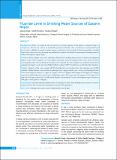Please use this identifier to cite or link to this item:
https://hdl.handle.net/20.500.14356/1482| Title: | Fluoride Level in Drinking Water Sources of Eastern Nepal |
| Authors: | Singh, Abanish Shrestha, Ashish Bhagat, Tarakant |
| Citation: | SinghA., ShresthaA., & BhagatT. (2019). Fluoride Level in Drinking Water Sources of Eastern Nepal. Journal of Nepal Health Research Council, 16(41), 414-418. https://doi.org/10.33314/jnhrc.v16i41.1450 |
| Issue Date: | 2018 |
| Publisher: | Nepal Health Research Council |
| Article Type: | Original Article |
| Keywords: | Drinking water sources Eastern Nepal Fluoride concentration |
| Series/Report no.: | Oct-Dec 2018;1450 |
| Abstract: | Abstract Background: Water is essential for the survival of every living organism of this planet, we humans being no exception to this fact. In context of oral health promotion, fluoride when consumed in recommended level decreases the solubility of enamel to acidic exposure and improves the strength of dental enamel that eventually helps reduce dental caries.So, this study was conducted to estimate the fluoride concentration in drinking water of eastern development region Nepal. Methods: Water samples (165) were randomly collected from drinking water sources of Eastern Development Region, Nepal. Three categories of water samples (municipal, natural, packaged bottle water) each from three most populated cities of every district in the region were collected. The water samples were collected in autoclaved polypropylene plastic vessels. American Public Health Association 4500 F- D method was used for fluoride estimation. Results: Majority of the water samples (88.2%) had fluoride concentration below the optimum as per WHO guideline. Median fluoride concentration of municipal water supply, natural water resources and packaged bottle water was 0.09 ppm (<0.05 to 1.11 ppm), 0.13 ppm (<0.05 to 1.80 ppm) and 0.05ppm (<0.05 ppm to 0.78 ppm) respectively. Median fluoride concentration of Himalayan region, hill region and terai region was 0.17 ppm, 0.10 ppm and 0.07 ppm respectively. Overall median fluoride concentration of eastern development region Nepal was 0.08 ppm (<0.05 pmm to 1.80 ppm). Conclusions: This study illustrated that fluoride concentration of most of the drinking water resources of eastern Nepal was below the recommended optimum level as per WHO guidelines. Keywords: Drinking water sources; eastern Nepal; fluoride concentration. |
| Description: | Original Article |
| URI: | http://103.69.126.140:8080/handle/20.500.14356/1482 |
| ISSN: | Print ISSN: 1727-5482; Online ISSN: 1999-6217 |
| Appears in Collections: | Vol. 16 No. 4 Issue 41 Oct - Dec 2018 |
Files in This Item:
| File | Description | Size | Format | |
|---|---|---|---|---|
| 1450-Manuscript-7833-3-10-20190221.pdf | Fulltext Article. | 618.01 kB | Adobe PDF |  View/Open |
Items in DSpace are protected by copyright, with all rights reserved, unless otherwise indicated.
